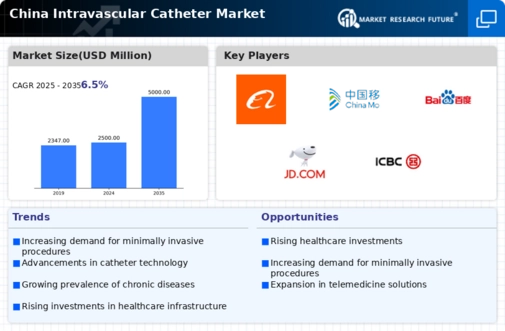Expansion of Healthcare Infrastructure
China's ongoing investment in healthcare infrastructure is significantly impacting the intravascular catheter market. The government has committed substantial resources to enhance healthcare facilities, particularly in rural areas, where access to advanced medical technologies has been limited. This expansion includes the establishment of new hospitals and clinics equipped with modern medical devices, including intravascular catheters. According to recent data, healthcare expenditure in China is expected to reach $1 trillion by 2025, indicating a robust growth trajectory. As healthcare facilities become more accessible, the utilization of intravascular catheters is likely to increase, driven by the need for efficient patient management and treatment options.
Growing Awareness of Infection Control
The heightened awareness surrounding infection control in medical settings is influencing the intravascular catheter market in China. Healthcare professionals are increasingly prioritizing the use of catheters designed to minimize the risk of infections, such as central line-associated bloodstream infections (CLABSIs). This shift is prompting manufacturers to innovate and develop advanced catheter technologies that incorporate antimicrobial properties. Data suggests that the implementation of infection control protocols can reduce CLABSI rates by up to 50%, thereby enhancing patient safety. Consequently, hospitals are more inclined to invest in high-quality intravascular catheters, which is likely to drive market growth as they seek to improve patient outcomes and comply with stringent regulatory standards.
Increasing Prevalence of Chronic Diseases
The rising incidence of chronic diseases in China, such as cardiovascular disorders and diabetes, is a primary driver for the intravascular catheter market. As these conditions necessitate frequent medical interventions, the demand for effective vascular access solutions is likely to increase. Reports indicate that cardiovascular diseases account for approximately 40% of all deaths in China, highlighting the urgent need for advanced medical devices. This trend suggests that healthcare providers are increasingly relying on intravascular catheters for diagnosis and treatment, thereby propelling market growth. Furthermore, the aging population, which is projected to reach 400 million by 2040, is expected to further amplify the demand for these devices, as older individuals are more susceptible to chronic health issues requiring catheterization.
Regulatory Initiatives and Quality Standards
The regulatory landscape in China is evolving, with increased emphasis on quality standards for medical devices, including intravascular catheters. The National Medical Products Administration (NMPA) has implemented stringent regulations to ensure the safety and efficacy of medical devices. This regulatory support is likely to foster innovation and encourage manufacturers to adhere to high-quality standards. As a result, healthcare providers may become more confident in utilizing intravascular catheters that meet these regulations, potentially leading to increased adoption rates. Furthermore, compliance with these standards may enhance market competitiveness, as hospitals and clinics seek reliable and safe catheter options for patient care.
Technological Innovations in Catheter Design
Innovations in catheter design and materials are playing a crucial role in shaping the intravascular catheter market. Manufacturers in China are increasingly focusing on developing catheters that offer enhanced performance, such as improved flexibility, biocompatibility, and reduced thrombogenicity. These advancements are essential for meeting the diverse needs of healthcare providers and patients. For instance, the introduction of bioengineered materials has shown promise in reducing complications associated with catheter use. As the market evolves, it appears that the demand for technologically advanced intravascular catheters will continue to rise, driven by the need for safer and more effective vascular access solutions.
















Leave a Comment